Analysis and Proposal: Education Gap Impact on Diabetes Care Outcomes
VerifiedAdded on 2020/12/18
|9
|1939
|115
Report
AI Summary
This report addresses the education gap within the healthcare setting, specifically focusing on diabetic nurses and its impact on patient outcomes. The report identifies a significant gap between theoretical knowledge and clinical practice among healthcare professionals, particularly novice nurses, which affects the application of treatment methods and understanding of cultural diversities in patient care. The analysis reveals that this education gap can lead to stress, anxiety, and difficulties in applying appropriate techniques, ultimately affecting the well-being of individuals with diabetes. To bridge this gap, the report proposes a short PowerPoint presentation as an educational tool, designed to facilitate a two-way interaction between presenters and diabetic nurses, allowing for the discussion of causes, implications, and solutions related to the education gap. The target audience is registered nurses involved in diabetes treatment, and the presentation aims to promote team work skills and address potential conflicts in treatment strategies, thereby improving the quality of diabetes care and patient outcomes. The report emphasizes the need for continuous learning and the importance of eliminating the educational gap within healthcare settings to ensure all individuals receive the same level of efficiency and quality of care.
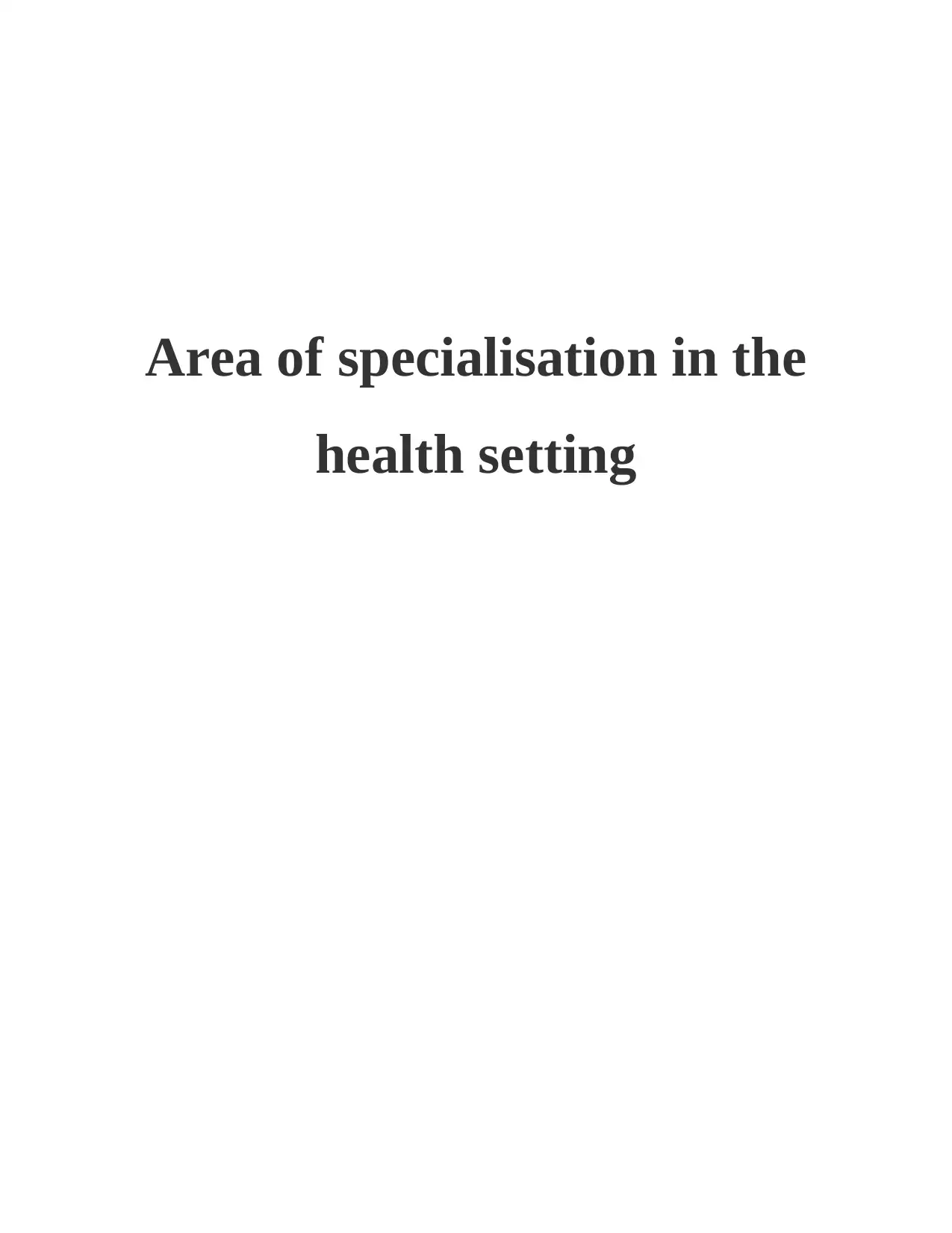
Area of specialisation in the
health setting
health setting
Paraphrase This Document
Need a fresh take? Get an instant paraphrase of this document with our AI Paraphraser
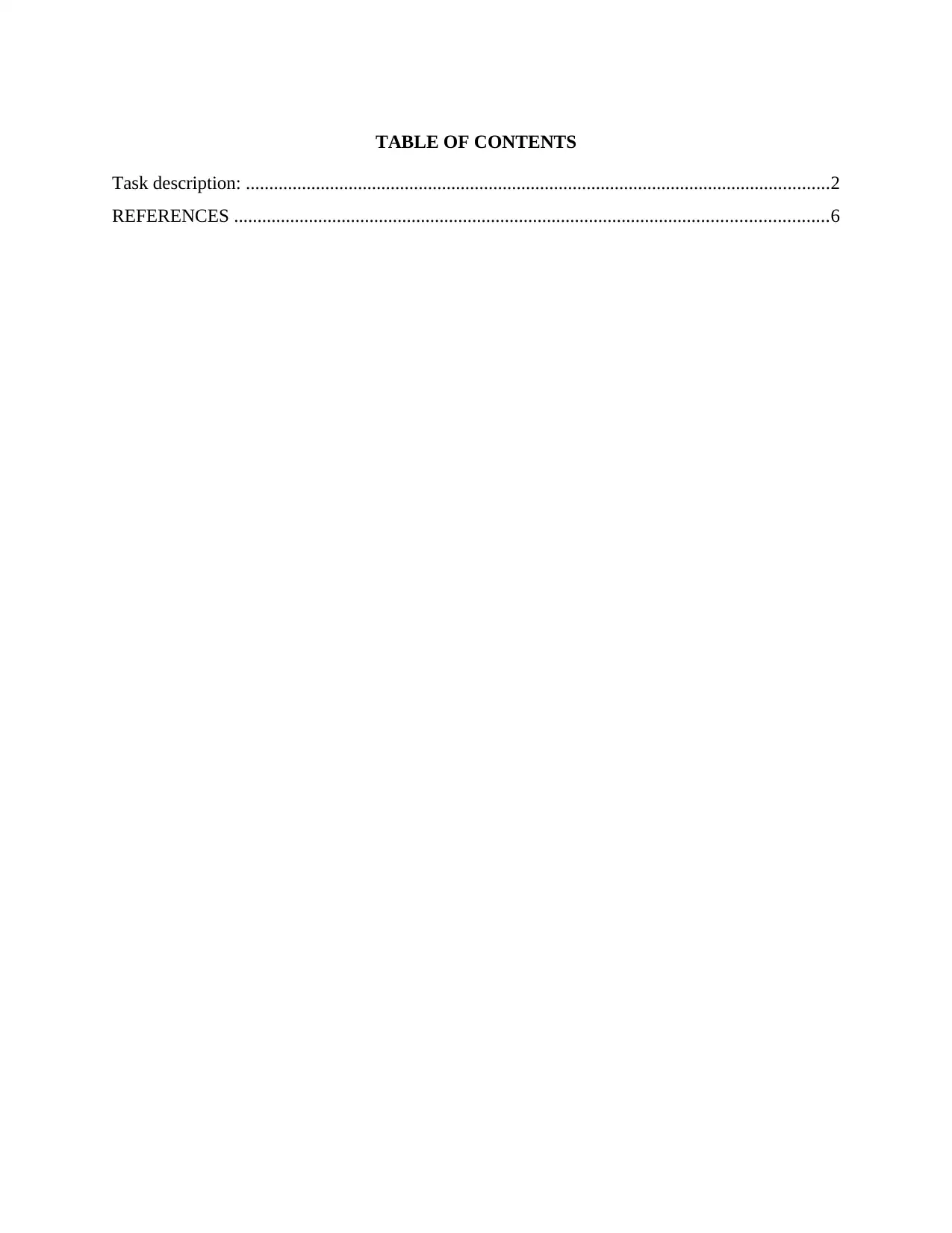
TABLE OF CONTENTS
Task description: .............................................................................................................................2
REFERENCES ...............................................................................................................................6
Task description: .............................................................................................................................2
REFERENCES ...............................................................................................................................6
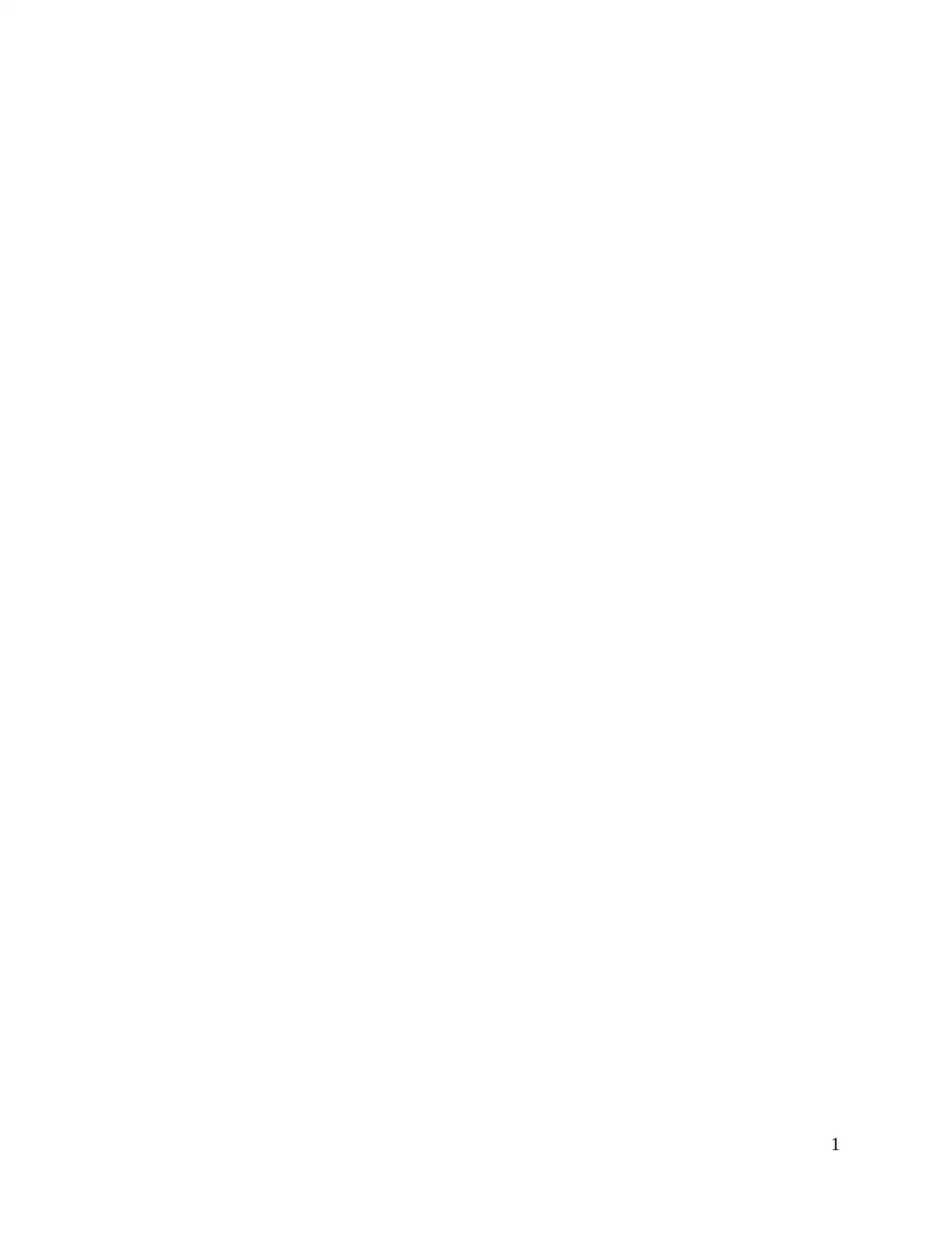
1
⊘ This is a preview!⊘
Do you want full access?
Subscribe today to unlock all pages.

Trusted by 1+ million students worldwide
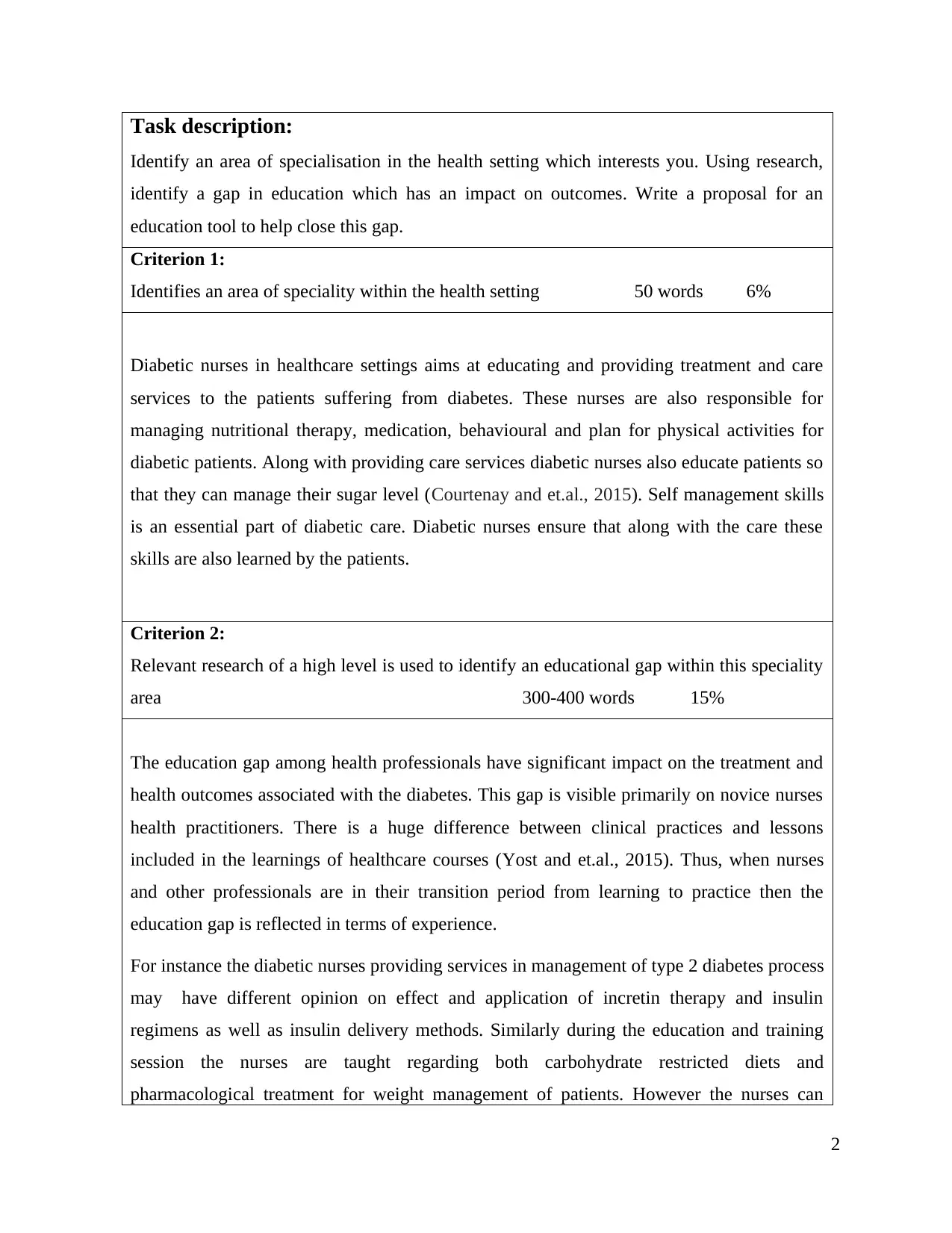
Task description:
Identify an area of specialisation in the health setting which interests you. Using research,
identify a gap in education which has an impact on outcomes. Write a proposal for an
education tool to help close this gap.
Criterion 1:
Identifies an area of speciality within the health setting 50 words 6%
Diabetic nurses in healthcare settings aims at educating and providing treatment and care
services to the patients suffering from diabetes. These nurses are also responsible for
managing nutritional therapy, medication, behavioural and plan for physical activities for
diabetic patients. Along with providing care services diabetic nurses also educate patients so
that they can manage their sugar level (Courtenay and et.al., 2015). Self management skills
is an essential part of diabetic care. Diabetic nurses ensure that along with the care these
skills are also learned by the patients.
Criterion 2:
Relevant research of a high level is used to identify an educational gap within this speciality
area 300-400 words 15%
The education gap among health professionals have significant impact on the treatment and
health outcomes associated with the diabetes. This gap is visible primarily on novice nurses
health practitioners. There is a huge difference between clinical practices and lessons
included in the learnings of healthcare courses (Yost and et.al., 2015). Thus, when nurses
and other professionals are in their transition period from learning to practice then the
education gap is reflected in terms of experience.
For instance the diabetic nurses providing services in management of type 2 diabetes process
may have different opinion on effect and application of incretin therapy and insulin
regimens as well as insulin delivery methods. Similarly during the education and training
session the nurses are taught regarding both carbohydrate restricted diets and
pharmacological treatment for weight management of patients. However the nurses can
2
Identify an area of specialisation in the health setting which interests you. Using research,
identify a gap in education which has an impact on outcomes. Write a proposal for an
education tool to help close this gap.
Criterion 1:
Identifies an area of speciality within the health setting 50 words 6%
Diabetic nurses in healthcare settings aims at educating and providing treatment and care
services to the patients suffering from diabetes. These nurses are also responsible for
managing nutritional therapy, medication, behavioural and plan for physical activities for
diabetic patients. Along with providing care services diabetic nurses also educate patients so
that they can manage their sugar level (Courtenay and et.al., 2015). Self management skills
is an essential part of diabetic care. Diabetic nurses ensure that along with the care these
skills are also learned by the patients.
Criterion 2:
Relevant research of a high level is used to identify an educational gap within this speciality
area 300-400 words 15%
The education gap among health professionals have significant impact on the treatment and
health outcomes associated with the diabetes. This gap is visible primarily on novice nurses
health practitioners. There is a huge difference between clinical practices and lessons
included in the learnings of healthcare courses (Yost and et.al., 2015). Thus, when nurses
and other professionals are in their transition period from learning to practice then the
education gap is reflected in terms of experience.
For instance the diabetic nurses providing services in management of type 2 diabetes process
may have different opinion on effect and application of incretin therapy and insulin
regimens as well as insulin delivery methods. Similarly during the education and training
session the nurses are taught regarding both carbohydrate restricted diets and
pharmacological treatment for weight management of patients. However the nurses can
2
Paraphrase This Document
Need a fresh take? Get an instant paraphrase of this document with our AI Paraphraser
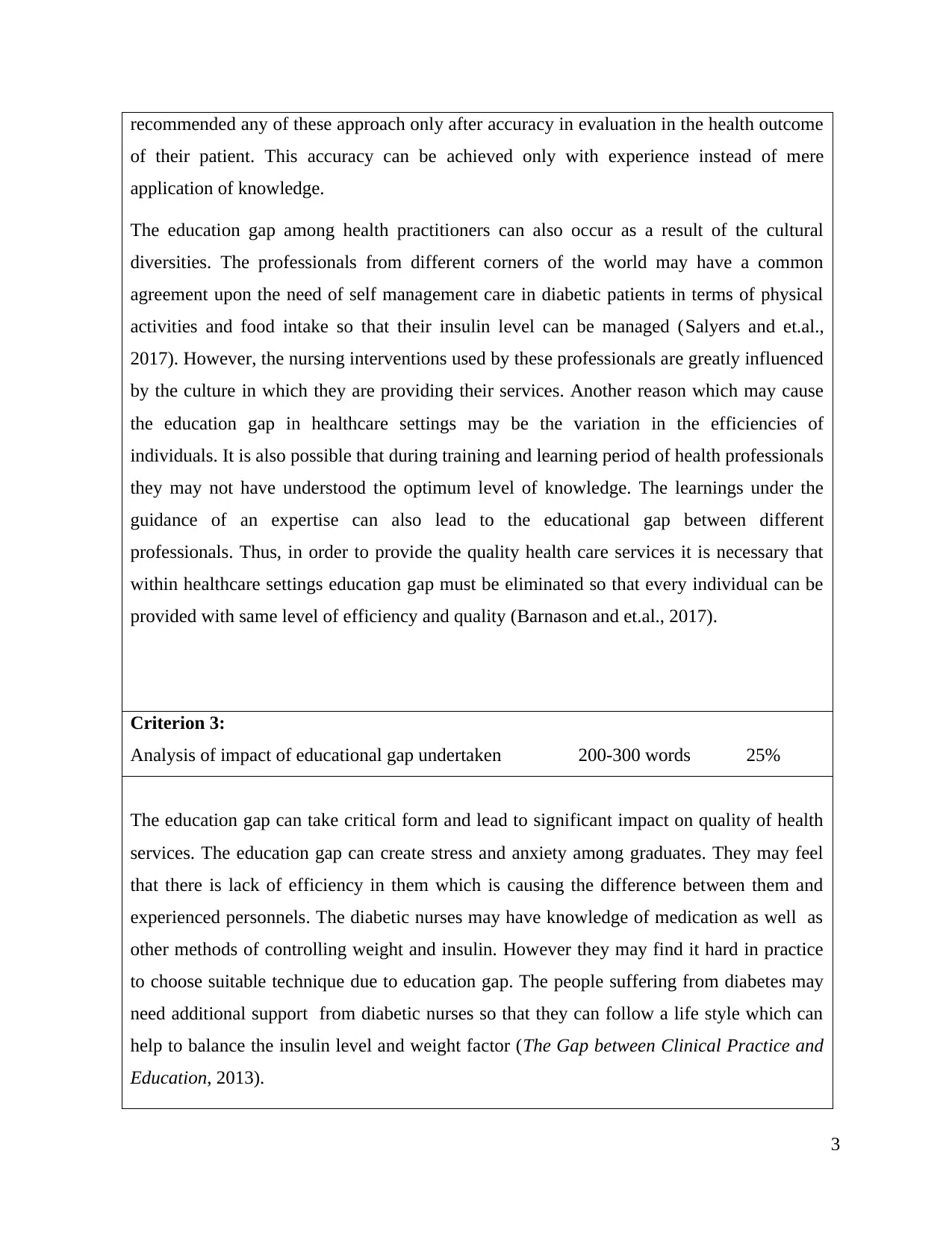
recommended any of these approach only after accuracy in evaluation in the health outcome
of their patient. This accuracy can be achieved only with experience instead of mere
application of knowledge.
The education gap among health practitioners can also occur as a result of the cultural
diversities. The professionals from different corners of the world may have a common
agreement upon the need of self management care in diabetic patients in terms of physical
activities and food intake so that their insulin level can be managed (Salyers and et.al.,
2017). However, the nursing interventions used by these professionals are greatly influenced
by the culture in which they are providing their services. Another reason which may cause
the education gap in healthcare settings may be the variation in the efficiencies of
individuals. It is also possible that during training and learning period of health professionals
they may not have understood the optimum level of knowledge. The learnings under the
guidance of an expertise can also lead to the educational gap between different
professionals. Thus, in order to provide the quality health care services it is necessary that
within healthcare settings education gap must be eliminated so that every individual can be
provided with same level of efficiency and quality (Barnason and et.al., 2017).
Criterion 3:
Analysis of impact of educational gap undertaken 200-300 words 25%
The education gap can take critical form and lead to significant impact on quality of health
services. The education gap can create stress and anxiety among graduates. They may feel
that there is lack of efficiency in them which is causing the difference between them and
experienced personnels. The diabetic nurses may have knowledge of medication as well as
other methods of controlling weight and insulin. However they may find it hard in practice
to choose suitable technique due to education gap. The people suffering from diabetes may
need additional support from diabetic nurses so that they can follow a life style which can
help to balance the insulin level and weight factor (The Gap between Clinical Practice and
Education, 2013).
3
of their patient. This accuracy can be achieved only with experience instead of mere
application of knowledge.
The education gap among health practitioners can also occur as a result of the cultural
diversities. The professionals from different corners of the world may have a common
agreement upon the need of self management care in diabetic patients in terms of physical
activities and food intake so that their insulin level can be managed (Salyers and et.al.,
2017). However, the nursing interventions used by these professionals are greatly influenced
by the culture in which they are providing their services. Another reason which may cause
the education gap in healthcare settings may be the variation in the efficiencies of
individuals. It is also possible that during training and learning period of health professionals
they may not have understood the optimum level of knowledge. The learnings under the
guidance of an expertise can also lead to the educational gap between different
professionals. Thus, in order to provide the quality health care services it is necessary that
within healthcare settings education gap must be eliminated so that every individual can be
provided with same level of efficiency and quality (Barnason and et.al., 2017).
Criterion 3:
Analysis of impact of educational gap undertaken 200-300 words 25%
The education gap can take critical form and lead to significant impact on quality of health
services. The education gap can create stress and anxiety among graduates. They may feel
that there is lack of efficiency in them which is causing the difference between them and
experienced personnels. The diabetic nurses may have knowledge of medication as well as
other methods of controlling weight and insulin. However they may find it hard in practice
to choose suitable technique due to education gap. The people suffering from diabetes may
need additional support from diabetic nurses so that they can follow a life style which can
help to balance the insulin level and weight factor (The Gap between Clinical Practice and
Education, 2013).
3
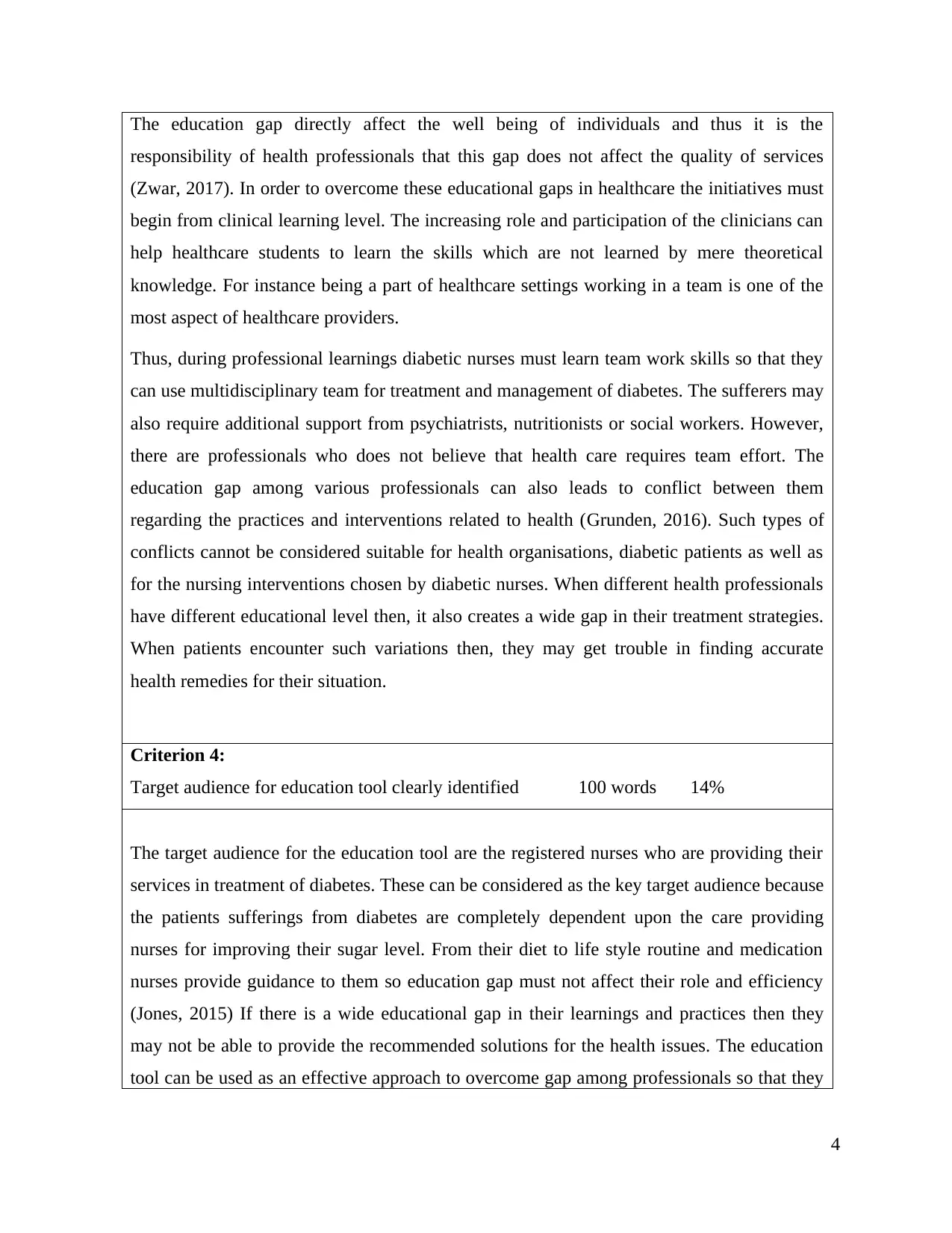
The education gap directly affect the well being of individuals and thus it is the
responsibility of health professionals that this gap does not affect the quality of services
(Zwar, 2017). In order to overcome these educational gaps in healthcare the initiatives must
begin from clinical learning level. The increasing role and participation of the clinicians can
help healthcare students to learn the skills which are not learned by mere theoretical
knowledge. For instance being a part of healthcare settings working in a team is one of the
most aspect of healthcare providers.
Thus, during professional learnings diabetic nurses must learn team work skills so that they
can use multidisciplinary team for treatment and management of diabetes. The sufferers may
also require additional support from psychiatrists, nutritionists or social workers. However,
there are professionals who does not believe that health care requires team effort. The
education gap among various professionals can also leads to conflict between them
regarding the practices and interventions related to health (Grunden, 2016). Such types of
conflicts cannot be considered suitable for health organisations, diabetic patients as well as
for the nursing interventions chosen by diabetic nurses. When different health professionals
have different educational level then, it also creates a wide gap in their treatment strategies.
When patients encounter such variations then, they may get trouble in finding accurate
health remedies for their situation.
Criterion 4:
Target audience for education tool clearly identified 100 words 14%
The target audience for the education tool are the registered nurses who are providing their
services in treatment of diabetes. These can be considered as the key target audience because
the patients sufferings from diabetes are completely dependent upon the care providing
nurses for improving their sugar level. From their diet to life style routine and medication
nurses provide guidance to them so education gap must not affect their role and efficiency
(Jones, 2015) If there is a wide educational gap in their learnings and practices then they
may not be able to provide the recommended solutions for the health issues. The education
tool can be used as an effective approach to overcome gap among professionals so that they
4
responsibility of health professionals that this gap does not affect the quality of services
(Zwar, 2017). In order to overcome these educational gaps in healthcare the initiatives must
begin from clinical learning level. The increasing role and participation of the clinicians can
help healthcare students to learn the skills which are not learned by mere theoretical
knowledge. For instance being a part of healthcare settings working in a team is one of the
most aspect of healthcare providers.
Thus, during professional learnings diabetic nurses must learn team work skills so that they
can use multidisciplinary team for treatment and management of diabetes. The sufferers may
also require additional support from psychiatrists, nutritionists or social workers. However,
there are professionals who does not believe that health care requires team effort. The
education gap among various professionals can also leads to conflict between them
regarding the practices and interventions related to health (Grunden, 2016). Such types of
conflicts cannot be considered suitable for health organisations, diabetic patients as well as
for the nursing interventions chosen by diabetic nurses. When different health professionals
have different educational level then, it also creates a wide gap in their treatment strategies.
When patients encounter such variations then, they may get trouble in finding accurate
health remedies for their situation.
Criterion 4:
Target audience for education tool clearly identified 100 words 14%
The target audience for the education tool are the registered nurses who are providing their
services in treatment of diabetes. These can be considered as the key target audience because
the patients sufferings from diabetes are completely dependent upon the care providing
nurses for improving their sugar level. From their diet to life style routine and medication
nurses provide guidance to them so education gap must not affect their role and efficiency
(Jones, 2015) If there is a wide educational gap in their learnings and practices then they
may not be able to provide the recommended solutions for the health issues. The education
tool can be used as an effective approach to overcome gap among professionals so that they
4
⊘ This is a preview!⊘
Do you want full access?
Subscribe today to unlock all pages.

Trusted by 1+ million students worldwide
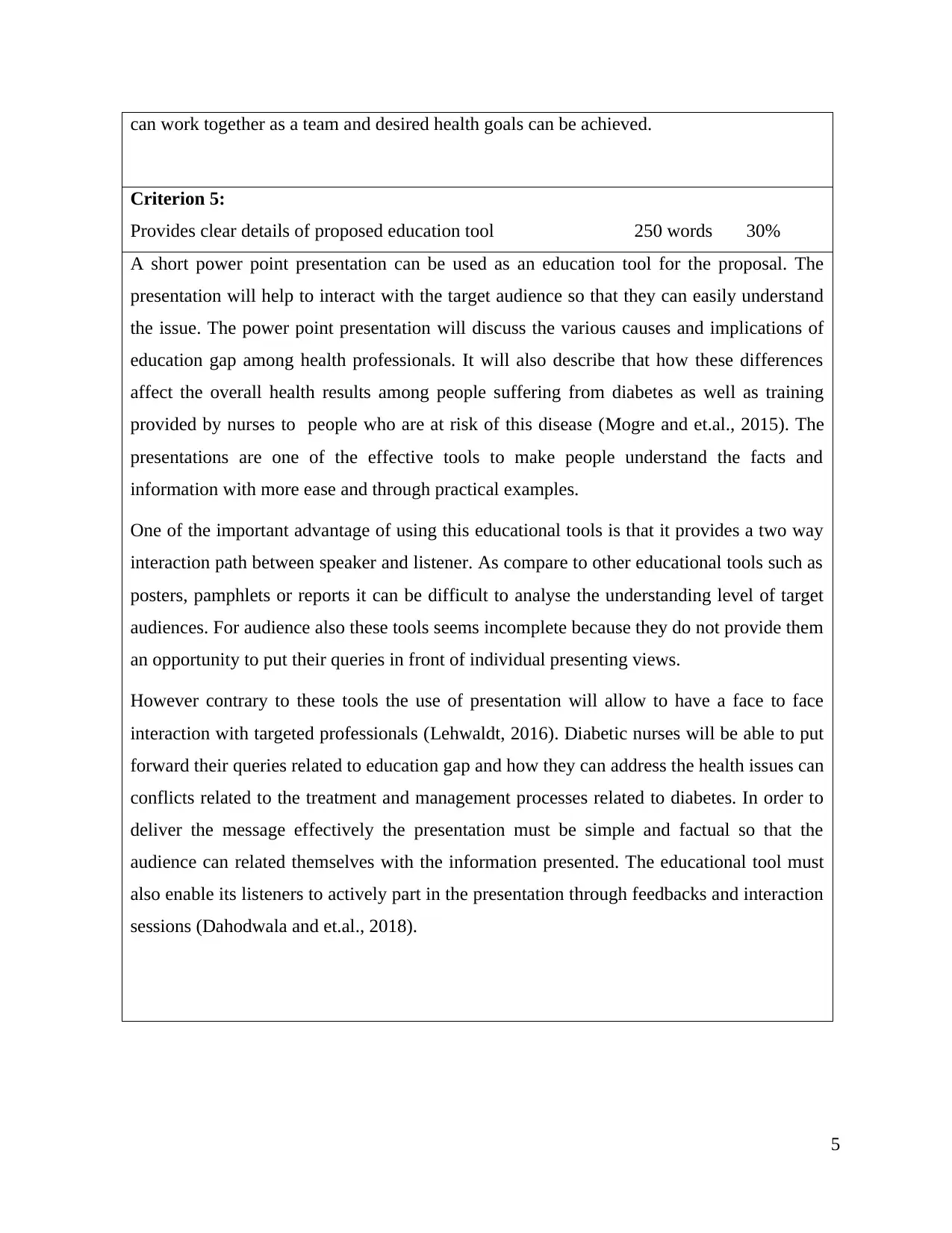
can work together as a team and desired health goals can be achieved.
Criterion 5:
Provides clear details of proposed education tool 250 words 30%
A short power point presentation can be used as an education tool for the proposal. The
presentation will help to interact with the target audience so that they can easily understand
the issue. The power point presentation will discuss the various causes and implications of
education gap among health professionals. It will also describe that how these differences
affect the overall health results among people suffering from diabetes as well as training
provided by nurses to people who are at risk of this disease (Mogre and et.al., 2015). The
presentations are one of the effective tools to make people understand the facts and
information with more ease and through practical examples.
One of the important advantage of using this educational tools is that it provides a two way
interaction path between speaker and listener. As compare to other educational tools such as
posters, pamphlets or reports it can be difficult to analyse the understanding level of target
audiences. For audience also these tools seems incomplete because they do not provide them
an opportunity to put their queries in front of individual presenting views.
However contrary to these tools the use of presentation will allow to have a face to face
interaction with targeted professionals (Lehwaldt, 2016). Diabetic nurses will be able to put
forward their queries related to education gap and how they can address the health issues can
conflicts related to the treatment and management processes related to diabetes. In order to
deliver the message effectively the presentation must be simple and factual so that the
audience can related themselves with the information presented. The educational tool must
also enable its listeners to actively part in the presentation through feedbacks and interaction
sessions (Dahodwala and et.al., 2018).
5
Criterion 5:
Provides clear details of proposed education tool 250 words 30%
A short power point presentation can be used as an education tool for the proposal. The
presentation will help to interact with the target audience so that they can easily understand
the issue. The power point presentation will discuss the various causes and implications of
education gap among health professionals. It will also describe that how these differences
affect the overall health results among people suffering from diabetes as well as training
provided by nurses to people who are at risk of this disease (Mogre and et.al., 2015). The
presentations are one of the effective tools to make people understand the facts and
information with more ease and through practical examples.
One of the important advantage of using this educational tools is that it provides a two way
interaction path between speaker and listener. As compare to other educational tools such as
posters, pamphlets or reports it can be difficult to analyse the understanding level of target
audiences. For audience also these tools seems incomplete because they do not provide them
an opportunity to put their queries in front of individual presenting views.
However contrary to these tools the use of presentation will allow to have a face to face
interaction with targeted professionals (Lehwaldt, 2016). Diabetic nurses will be able to put
forward their queries related to education gap and how they can address the health issues can
conflicts related to the treatment and management processes related to diabetes. In order to
deliver the message effectively the presentation must be simple and factual so that the
audience can related themselves with the information presented. The educational tool must
also enable its listeners to actively part in the presentation through feedbacks and interaction
sessions (Dahodwala and et.al., 2018).
5
Paraphrase This Document
Need a fresh take? Get an instant paraphrase of this document with our AI Paraphraser
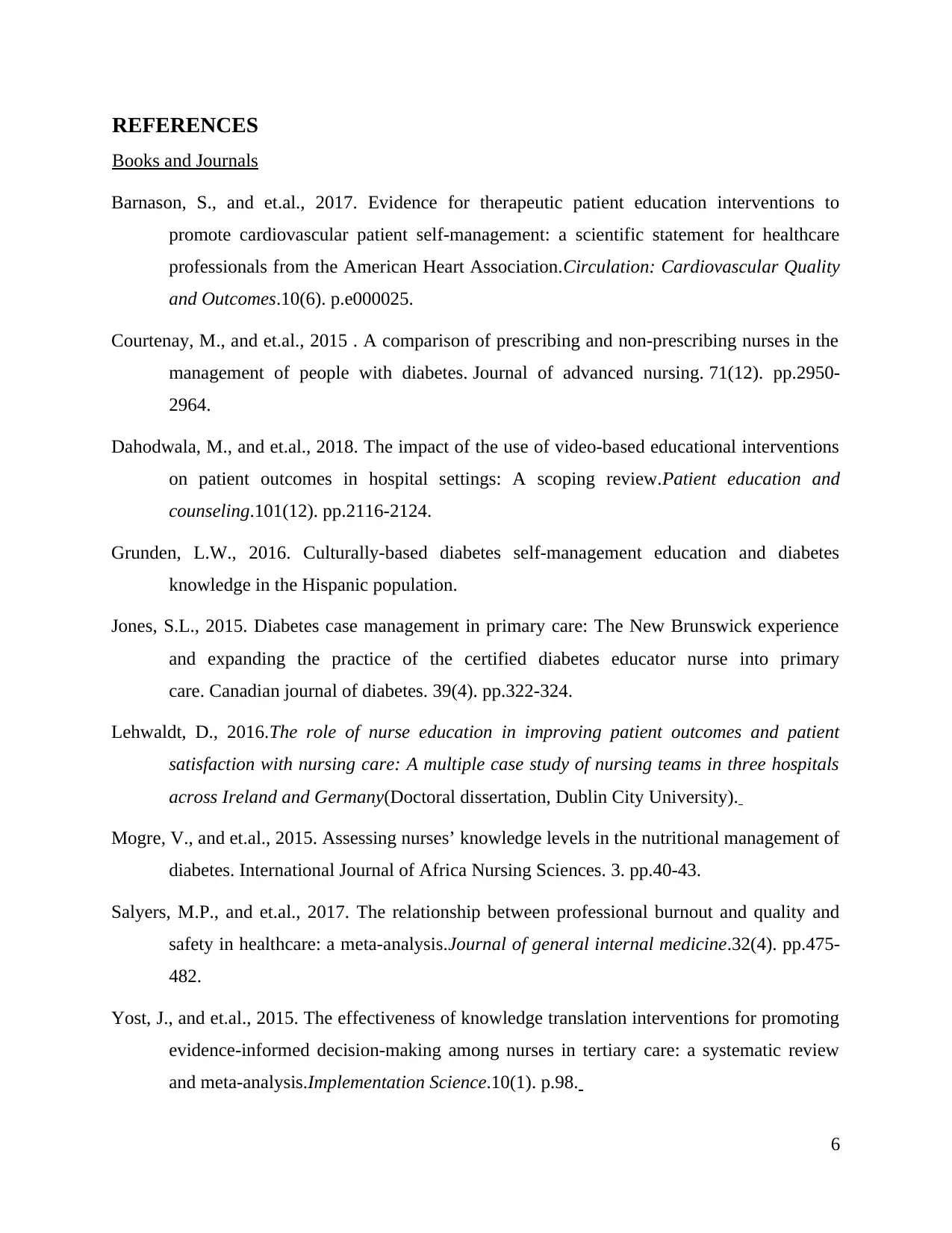
REFERENCES
Books and Journals
Barnason, S., and et.al., 2017. Evidence for therapeutic patient education interventions to
promote cardiovascular patient self-management: a scientific statement for healthcare
professionals from the American Heart Association.Circulation: Cardiovascular Quality
and Outcomes.10(6). p.e000025.
Courtenay, M., and et.al., 2015 . A comparison of prescribing and non‐prescribing nurses in the
management of people with diabetes. Journal of advanced nursing. 71(12). pp.2950-
2964.
Dahodwala, M., and et.al., 2018. The impact of the use of video-based educational interventions
on patient outcomes in hospital settings: A scoping review.Patient education and
counseling.101(12). pp.2116-2124.
Grunden, L.W., 2016. Culturally-based diabetes self-management education and diabetes
knowledge in the Hispanic population.
Jones, S.L., 2015. Diabetes case management in primary care: The New Brunswick experience
and expanding the practice of the certified diabetes educator nurse into primary
care. Canadian journal of diabetes. 39(4). pp.322-324.
Lehwaldt, D., 2016.The role of nurse education in improving patient outcomes and patient
satisfaction with nursing care: A multiple case study of nursing teams in three hospitals
across Ireland and Germany(Doctoral dissertation, Dublin City University).
Mogre, V., and et.al., 2015. Assessing nurses’ knowledge levels in the nutritional management of
diabetes. International Journal of Africa Nursing Sciences. 3. pp.40-43.
Salyers, M.P., and et.al., 2017. The relationship between professional burnout and quality and
safety in healthcare: a meta-analysis.Journal of general internal medicine.32(4). pp.475-
482.
Yost, J., and et.al., 2015. The effectiveness of knowledge translation interventions for promoting
evidence-informed decision-making among nurses in tertiary care: a systematic review
and meta-analysis.Implementation Science.10(1). p.98.
6
Books and Journals
Barnason, S., and et.al., 2017. Evidence for therapeutic patient education interventions to
promote cardiovascular patient self-management: a scientific statement for healthcare
professionals from the American Heart Association.Circulation: Cardiovascular Quality
and Outcomes.10(6). p.e000025.
Courtenay, M., and et.al., 2015 . A comparison of prescribing and non‐prescribing nurses in the
management of people with diabetes. Journal of advanced nursing. 71(12). pp.2950-
2964.
Dahodwala, M., and et.al., 2018. The impact of the use of video-based educational interventions
on patient outcomes in hospital settings: A scoping review.Patient education and
counseling.101(12). pp.2116-2124.
Grunden, L.W., 2016. Culturally-based diabetes self-management education and diabetes
knowledge in the Hispanic population.
Jones, S.L., 2015. Diabetes case management in primary care: The New Brunswick experience
and expanding the practice of the certified diabetes educator nurse into primary
care. Canadian journal of diabetes. 39(4). pp.322-324.
Lehwaldt, D., 2016.The role of nurse education in improving patient outcomes and patient
satisfaction with nursing care: A multiple case study of nursing teams in three hospitals
across Ireland and Germany(Doctoral dissertation, Dublin City University).
Mogre, V., and et.al., 2015. Assessing nurses’ knowledge levels in the nutritional management of
diabetes. International Journal of Africa Nursing Sciences. 3. pp.40-43.
Salyers, M.P., and et.al., 2017. The relationship between professional burnout and quality and
safety in healthcare: a meta-analysis.Journal of general internal medicine.32(4). pp.475-
482.
Yost, J., and et.al., 2015. The effectiveness of knowledge translation interventions for promoting
evidence-informed decision-making among nurses in tertiary care: a systematic review
and meta-analysis.Implementation Science.10(1). p.98.
6
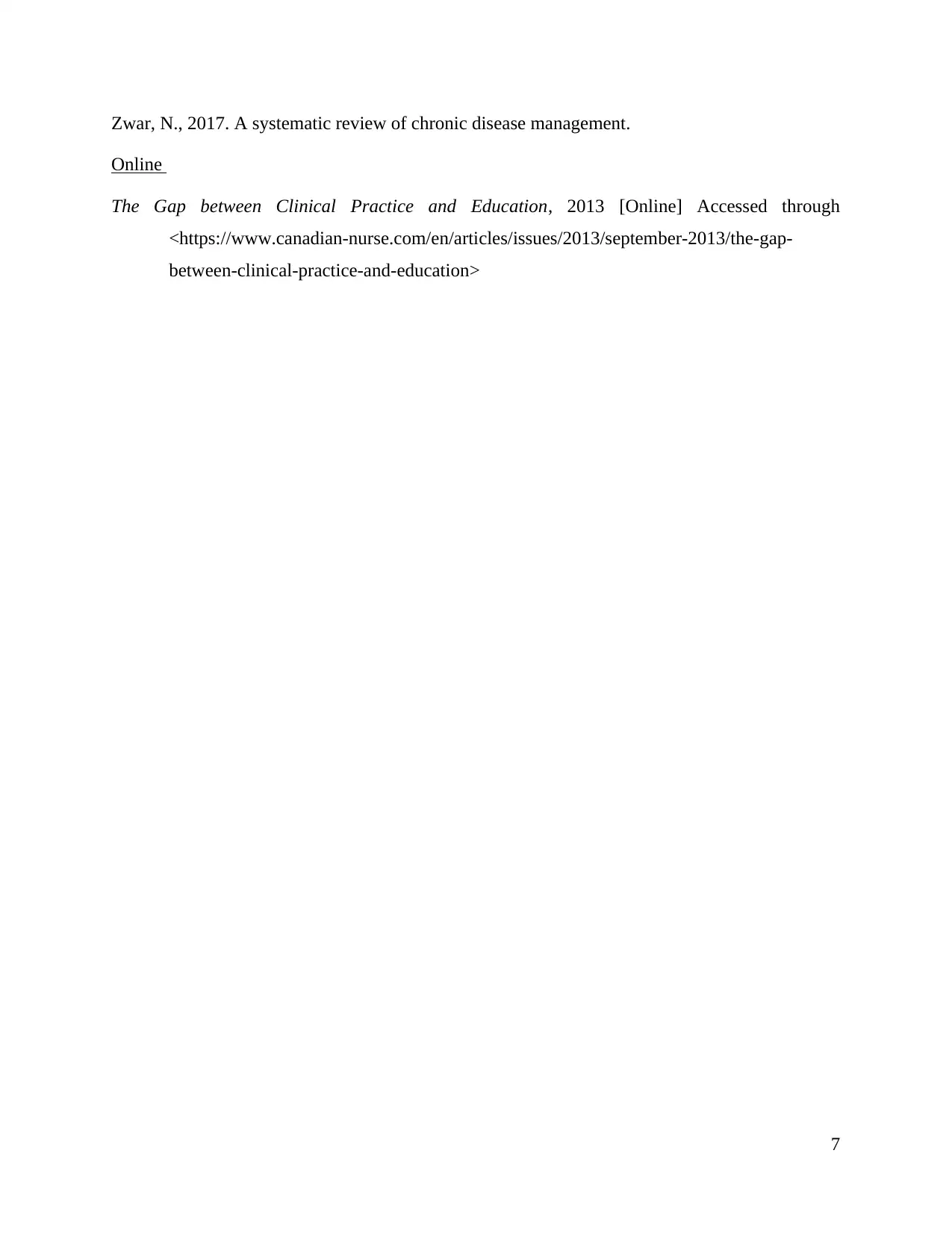
Zwar, N., 2017. A systematic review of chronic disease management.
Online
The Gap between Clinical Practice and Education, 2013 [Online] Accessed through
<https://www.canadian-nurse.com/en/articles/issues/2013/september-2013/the-gap-
between-clinical-practice-and-education>
7
Online
The Gap between Clinical Practice and Education, 2013 [Online] Accessed through
<https://www.canadian-nurse.com/en/articles/issues/2013/september-2013/the-gap-
between-clinical-practice-and-education>
7
⊘ This is a preview!⊘
Do you want full access?
Subscribe today to unlock all pages.

Trusted by 1+ million students worldwide
1 out of 9
Related Documents
Your All-in-One AI-Powered Toolkit for Academic Success.
+13062052269
info@desklib.com
Available 24*7 on WhatsApp / Email
![[object Object]](/_next/static/media/star-bottom.7253800d.svg)
Unlock your academic potential
Copyright © 2020–2025 A2Z Services. All Rights Reserved. Developed and managed by ZUCOL.





